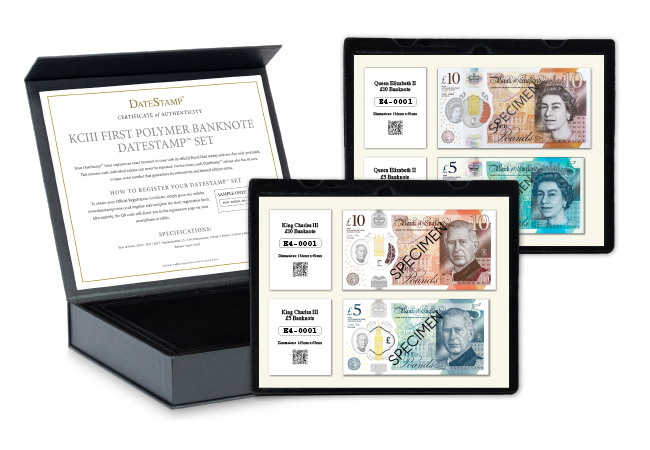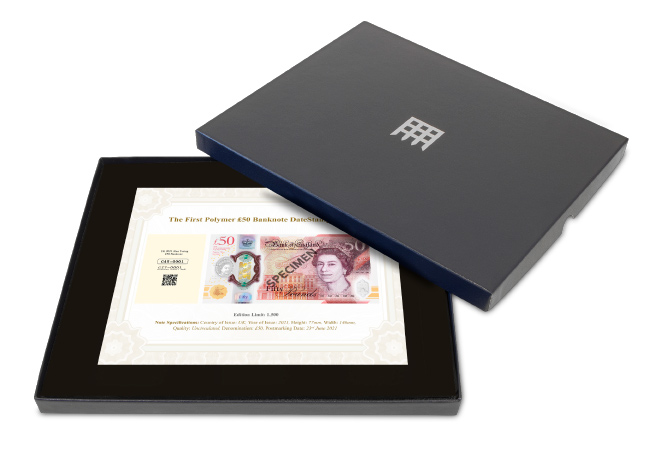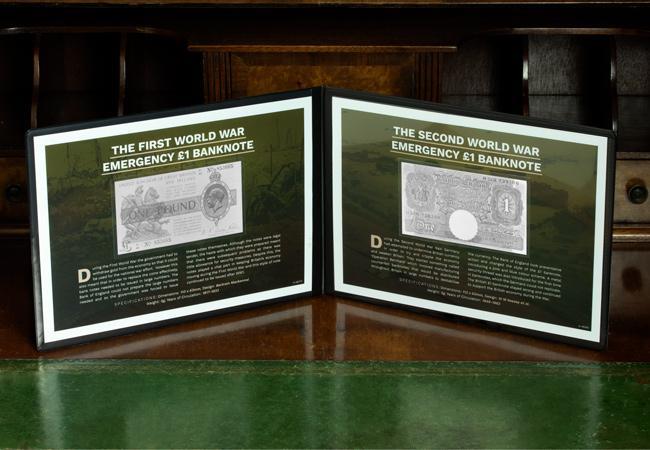Posts Tagged ‘banknote’
The Evolution of UK Banknotes: From Paper to Precision
The history of banknotes in the United Kingdom is a fascinating journey of innovation, security, and tradition. From the earliest issues to the forthcoming King Charles III banknotes, each phase reflects the technological and cultural shifts of its time.
A Brief History of UK Banknotes
The Bank of England began issuing banknotes shortly after its establishment in 1694. Initially, these notes were handwritten, a far cry from the highly sophisticated currency we use today. By the mid-18th century, partially printed notes were introduced, with the denomination and other details filled in by hand.
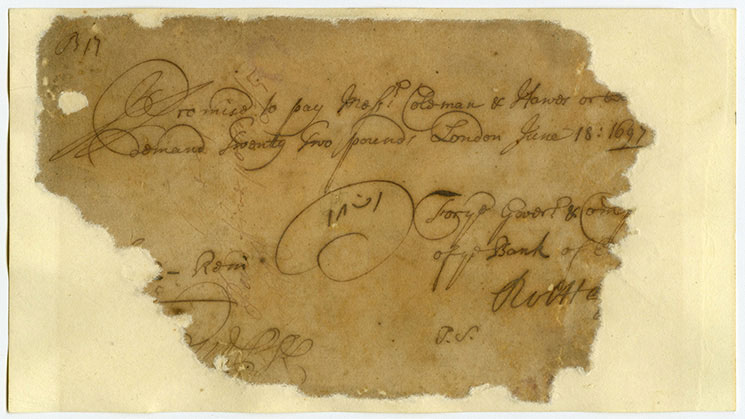
Source: Bank of England website
https://www.bankofengland.co.uk/museum/online-collections/blog/our-earliest-bank-of-england-note
The 19th century brought significant changes with fully printed notes and the introduction of standardized designs to prevent forgery. A pivotal moment in the history of UK banknotes came in 1960 when Queen Elizabeth II became the first monarch to be featured on the Bank of England notes. Her portrait on the £1 note marked the beginning of a tradition of depicting reigning monarchs on the nation’s currency, providing a sense of continuity and national identity.
Security Features: From Simplicity to Sophistication
As technology advanced, so did the sophistication of banknote security features. Early notes relied heavily on the quality of the paper and intricate designs to deter counterfeiters. However, as counterfeiting techniques improved, so too did the security measures.
Modern UK banknotes are a marvel of technology and design. Click on the dots below to explore the key security features:
Introducing the King Charles III Banknotes
In a historic move, the Bank of England is set to release the new King Charles III banknotes on June 5th, 2024. This marks the first time in over 70 years that a new monarch’s portrait will grace the currency, following the reign of Queen Elizabeth II.
The King Charles III banknotes will continue to feature the same high-security features of their predecessors and the new banknotes will initially be available in £5, £10, £20, and £50 denominations. They will circulate alongside the existing Queen Elizabeth II notes, gradually phasing out the older series as they wear out.
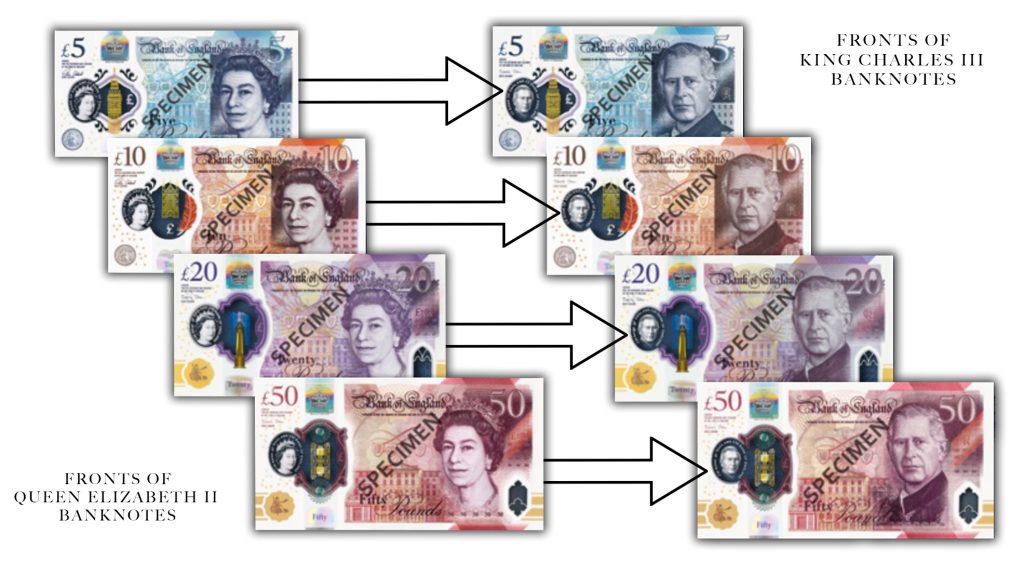
Introducing the DateStamp™ Set: Connecting the Past and Present
To commemorate this historic transition, we are excited to introduce an exclusive DateStamp™ set that brings together the past and the present of UK currency. This unique collection features the Queen Elizabeth II £5 and £10 banknotes alongside the brand new King Charles III £5 and £10 banknotes, each postmarked on the official issue date, 5th June, 2024.
You can now be one of just 2,024 collectors to own this special set.
Click here now to pre-order yours before the official release >>
The secrets hidden in the NEW Alan Turing £50 banknote…
Whether you love them or hate them, it’s fair to say that when the Bank of England issued the very first polymer banknotes, UK currency was revolutionised. As well as refreshing the designs of the notes, these polymer versions were considered a cleaner, safer, and stronger alternative.
In 2016 it was the £5 that received the first makeover, and Winston Churchill was selected to feature on the note. Jane Austen soon followed on the £10 note and JMW Turner was selected to feature on the £20 polymer note last year.
Now, the scarcest and largest banknote in circulation – the £50 banknote – has received the same polymer makeover treatment, and on 23rd June 2021 the brand new polymer banknote featuring Alan Turning was released.
But it’s not only the design that makes this note special. You see, the Bank of England have described their polymer notes as the most secure series of banknotes yet. So, I’m of course curious to see what special security features have been worked into the design of our newest banknote…
Britain’s most secure banknote
Before the revolutionary polymer £50 came along, The Bank of England estimated that there were over 350 million £50 paper banknotes in circulation in the UK in 2021 – the lowest number of all UK banknotes.
Last year, approximately 20,000 counterfeit £50 notes were seized by The Bank of England – the second highest number of counterfeits out of all UK banknote denominations. When you consider that, it’s understandable that the need to make the new £50 polymer banknote difficult to counterfeit was at the forefront of the designer’s mind!
Let’s take a look at some of the security features incorporated into the design:
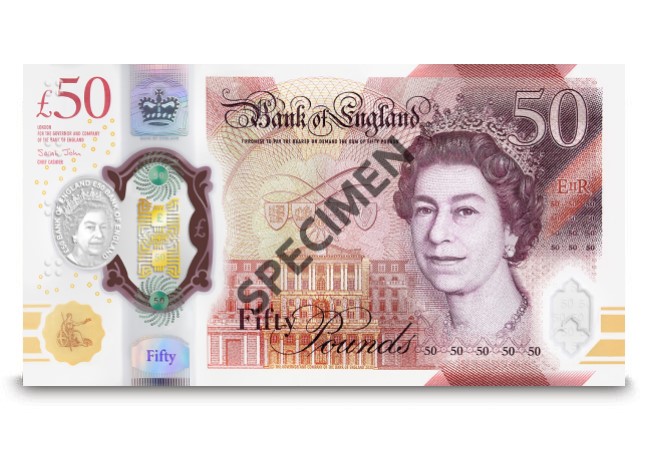
- Transparent windows – the foil in the large see-through window is green and gold on the front, and silver on the back. Within the gold foil squares the image changes between ‘50’ and a ‘£’ symbol when tilted. Plus, there’s a second, smaller window in the bottom corner.
- Changing holograms – the hologram beneath the large clear pane will alternate between reading ‘Fifty’ and ‘Pounds’ depending on what way you tilt the note.
- The Queen’s portrait in the transparent window – the Queen’s portrait is printed on the window with ‘£50 Bank of England’ printed twice around the edge.
- Foil patches – a silver foil patch contains a 3D image of the coronation crown. There is a second red foil patch which contains the letters ‘AT’.
- Ultra-violet technology – under UV light, the number ’50’ appears in bright red and green on the front of the note, against a duller background.
- Raised dots – you’ll find four clusters of raised dots in the top left hand corner. This tactile feature helps blind and partially sighted people identify the value of the note.
Alan Turing design
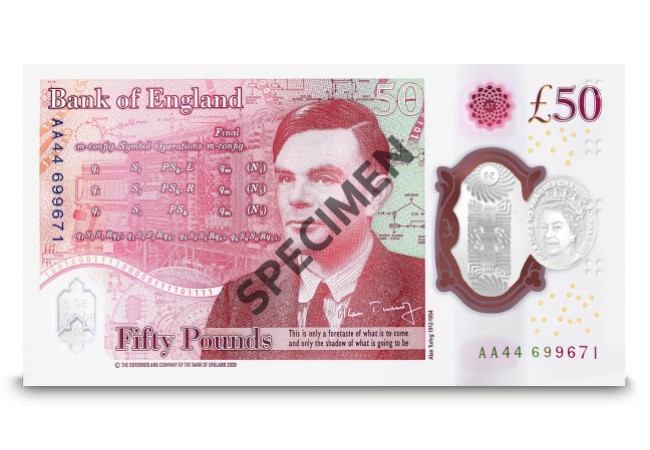
In 2018 the Banknote Character Advisory Committee chose to celebrate the field of science on the £50 note. Following this, nominations were accepted by the public over six weeks, accumulating over 225,000 nominations and 989 individual characters for consideration. 12 names were shortlisted, and Alan Turing was finally selected by the Governor of the Bank of England.
The note itself features a portrait of Turing based on a photo taken in 1951 by Elliot & Fry which is part of the Photographs Collection at the National Portrait Gallery. The artwork on the reverse of the note celebrates Turing’s pioneering mathematics and work with computers.
Most notably the design features technical drawings for the British Bombe, the machine specified by Turing and one of the primary tools used to break Enigma-enciphered messages during WWII.
Stationed at Bletchley Park, he played a pivotal role in cracking intercepted coded messages that enabled the Allies to defeat the Nazis in many crucial engagements, including the Battle of the Atlantic. It’s estimated that this work shortened the war in Europe by more than two years and saved over 14 million lives.
What do you think about the new £50 Polymer note? Let us know in the comments!
If you’re interested…
If you’re looking for a way to own this significant, revolutionary piece of British currency, then look no further than the UK 2021 £50 Polymer Banknote DateStamp™ issue. Each DateStamp™ issue has been postmarked by Royal Mail with the note’s first day of release – 23rd June 2021 – forever ensuring its provenance.
First issues are always valued by collectors and by owning the DateStamp™ issue you will be one of just 995 collectors able to forever mark the date the new £50 polymer banknote entered circulation. We have a limited number available, so click here to find out more >>
The British banknote set to sell for up to £12,000!
Tomorrow on 28th October a Victorian £5 Banknote is set to sell at auction catalogued at up to £12,000! Now you might be wondering how an old piece of paper could be worth such an extortionate price. Well, even though it is over 150 years old, the banknote is in pristine condition – almost as if it has come straight from the Victorian Cashier who issued it himself!
The £5 Banknote, dated for the 28th December 1863 is a representation of the height of the industrial period and the advances made in Victorian Britain. In fact the design and printing technology was so advanced that the exact design was used up until 1956! You see, British Banknotes have an incredible history that is often overlooked in the collecting world…
The First UK Banknote
In 1694 King William III was at war with France, and as is often the case with warfare, the financial state of the nation was put under pressure. And so the Bank of England was established. One of its main jobs was to issue banknotes in return for deposits of gold or silver. It’s thought that the first banknote ever issued was one for £1000! But seeing as most people’s wages were less than £20 a year in those days, most people never saw a banknote.
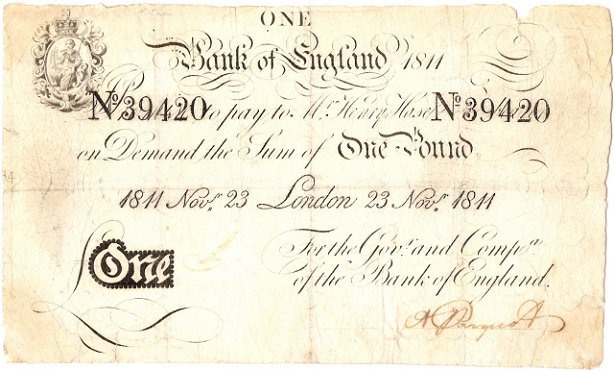
Each banknote was handwritten on bank paper addressed to the payee, and signed by a cashier to authenticate it –sort of like a modern day cheque. This is a tradition that continues today as each banknote is issued with the Chief Cashier’s signature.
“I promise to pay the barer on demand the sum of five pounds”
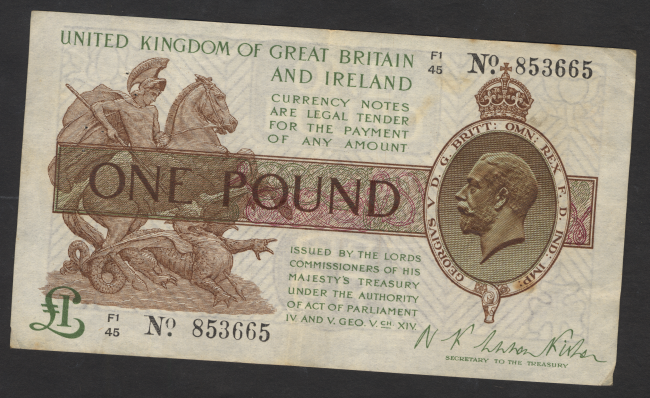
Before 1853 banknotes were completely handwritten, but the innovation of the Victorian period meant that templates for banknotes could be printed. Therefore cashiers no longer had to sign each note individually. The words “I promise to pay the bearer on demand the sum of Five pounds” were introduced to link the notes to a physical gold value. In theory, anyone could go to the bank and ask them to give them £5 worth of gold in exchange for a £5 banknote, although the meaning has changed today, the tradition remains on the banknotes.
Emergency Wartime issues
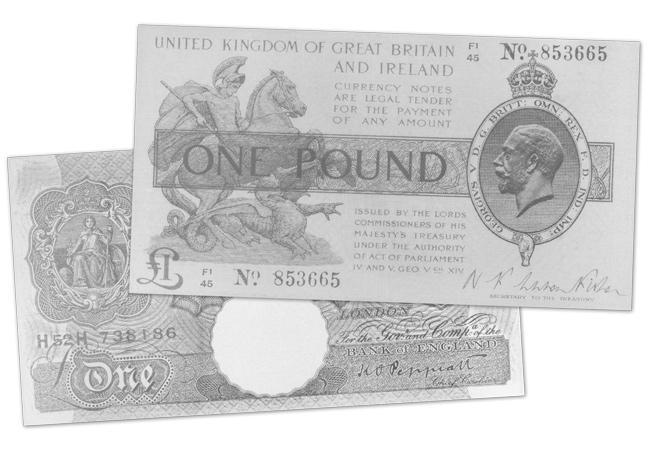
During the First World War, gold was preserved by the government and gold coins in circulation had to be withdrawn. To replace these coins, the Bank of England needed to make a large supply of £1 and 10/- notes available, but the haste at which these were produced meant that there were huge security problems. The notes were too small for cashiers to handle and they had very few anti-counterfeiting measures, but the notes themselves played a vital role in keeping the economy going.
The Second World War Nazi threat

During World War Two, the British government found out about a Nazi plot to introduced thousands of fake banknotes to destabilise British currency. However the Bank of England took emergency action and changed the colour of some of the notes for the duration of the war. The Nazi’s could not match the high levels of security features on the British banknotes and their plans failed.
Polymer banknotes
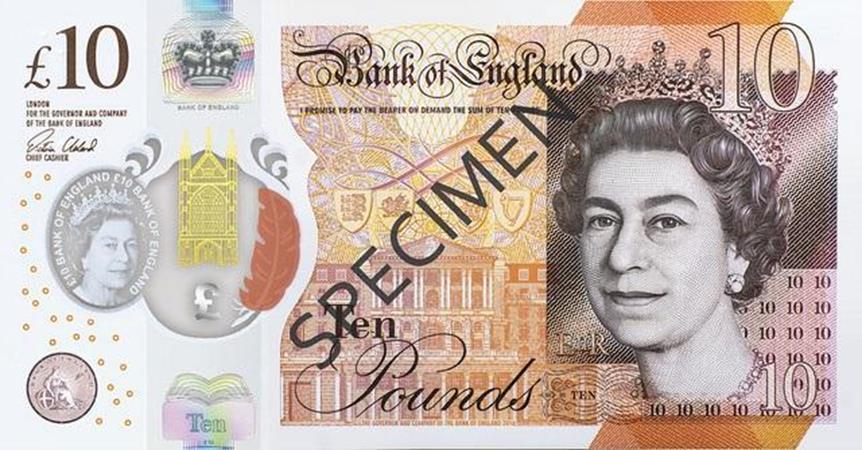
Today historic banknotes are harder and harder to get hold of, especially the ones in good condition, and those that are will often sell for thousands of pounds. Few have seen the earlier banknotes, and a small number of us remember using pre-decimal or war time banknotes in our childhoods. This is largely because the paper design which made them more susceptible to damage, so many have been lost over time. The new polymer banknotes first issued in 2016 marked a monumental change in numismatic history, bringing new technology and innovation to our pockets.
If you’re interested
Today you have the chance to own a limited edition pair of Emergency Wartime Banknote reproductions, each struck from 5g of FINE SILVER.
The Emergency Banknotes each carry a fascinating story, and your Silver versions come complete in a presentation folder telling the full story of how these banknotes helped Britain win the war.
JUST 100 of these special FINE SILVER banknotes pairs are available, so click here to order yours now, before it’s too late >>

